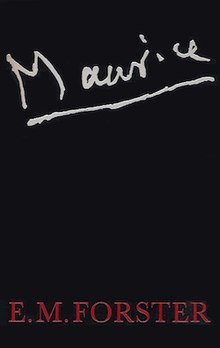
Back Maurice (román) Czech Maurice (Roman) German Maurice (novela) Spanish موریس (رمان) Persian Maurice (roman) French Maurice (romanzo) Italian モーリス (小説) Japanese Maurice (E. M. Forster) Latin Maurice (roman) NB Maurice (livro) Portuguese
 UK first edition cover | |
| Author | E. M. Forster |
|---|---|
| Country | United Kingdom |
| Language | English |
| Genre | Gay novel |
| Publisher | Hodder Arnold |
Publication date | January 1971 |
| Media type | |
| Pages | 256 |
| ISBN | 0-713-15600-7 |
Maurice is a novel by E. M. Forster. A tale of homosexual love in early 20th-century England, it follows Maurice Hall from his schooldays through university and beyond. It was written in 1913–1914 and revised in 1932 as well as 1952–1960 (each version differs from one another in the novel's last part).[1][2] Forster was an admirer of the poet, philosopher, socialist, and early gay rights activist Edward Carpenter and, following a visit to Carpenter's home at Millthorpe, Derbyshire in 1913, was inspired to write Maurice. The cross-class relationship between Carpenter and his working-class partner, George Merrill, presented a real-life model for that of Maurice and Alec Scudder.[3][4]
Although Forster showed different versions of the novel to a select few of his trusted friends (among them Siegfried Sassoon, Lytton Strachey, Edward Carpenter, Christopher Isherwood, Xiao Qian and Forrest Reid) throughout the decades,[5][6] it was published only posthumously, in 1971. Forster did not seek to publish it during his lifetime, believing it to have been unpublishable during that period owing to public and legal attitudes to same-sex love. A note found on the manuscript read: "Publishable, but worth it?" Forster was determined that his novel should have a happy ending, but also feared that this would make the book liable to prosecution while male homosexuality remained illegal in the UK.[7]
There has been speculation that Forster's unpublished manuscript may have been seen by D. H. Lawrence and influenced his 1928 novel Lady Chatterley's Lover, which also involves a gamekeeper becoming the lover of a member of the upper classes.[8]
The novel has been adapted by James Ivory and Kit Hesketh-Harvey as the 1987 Merchant Ivory Productions film Maurice, for the stage, and as a 2007 BBC Radio 4 Classic Serial by Philip Osment.
- ^ Miracky, James J. (2003). Regenerating the Novel: Gender and Genre in Woolf, Forster, Sinclair and Lawrence. New York City: Routledge. p. 55. ISBN 0-4159-4205-5.
- ^ Isherwood, Christopher (2010). Katherine Bucknell (ed.). The Sixties: Diaries, Volume Two 1960–1969. New York City: HarperCollins. p. 631. ISBN 978-0-06-118019-4.
- ^ Symondson, Kate (25 May 2016) E M Forster's gay fiction . The British Library website. Retrieved 18 July 2020
- ^ Rowse, A. L. (1977). Homosexuals in History: A Study of Ambivalence in Society, Literature, and the Arts. New York City: Macmillan. pp. 282–283. ISBN 0-88029-011-0.
- ^ Laurence, Patricia Ondek (2003). Lily Briscoe's Chinese eyes : Bloomsbury, modernism, and China. Columbia: University of South Carolina Press. p. 196. ISBN 978-1-61117-176-1. OCLC 835136845.
- ^ Phillips, Richard; Shuttleton, David; Watt, Diane (2000). De-Centering Sexualities: Politics and Representations Beyond the Metropolis. Routledge. p. 135. ISBN 9780415194662. OCLC 1020497350.
- ^ Forster 1971, p. 236.
- ^ King, Dixie (1982) "The Influence of Forster's Maurice on Lady Chatterley's Lover" Contemporary Literature Vol. 23, No. 1 (Winter, 1982), pp. 65-82
© MMXXIII Rich X Search. We shall prevail. All rights reserved. Rich X Search